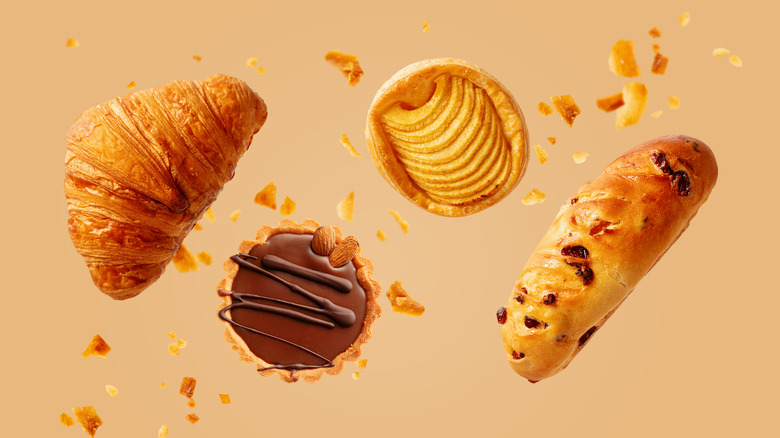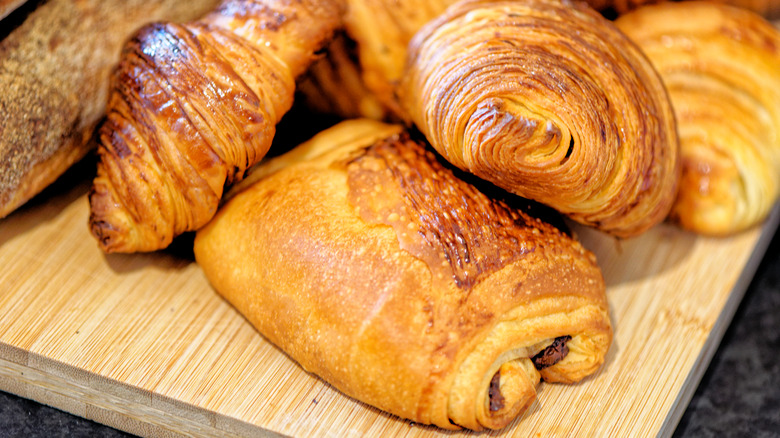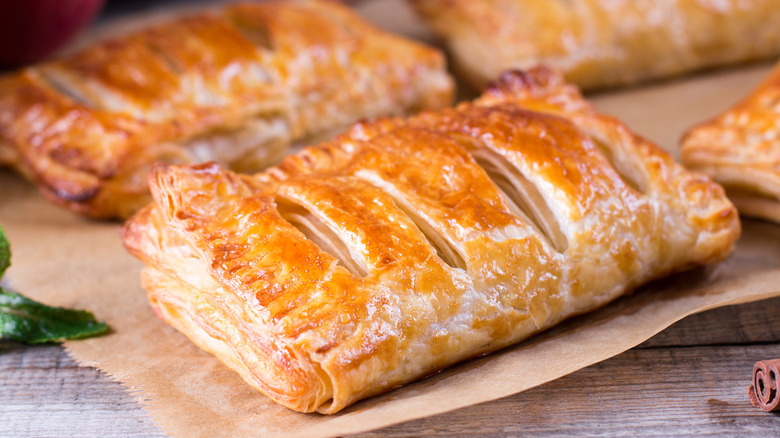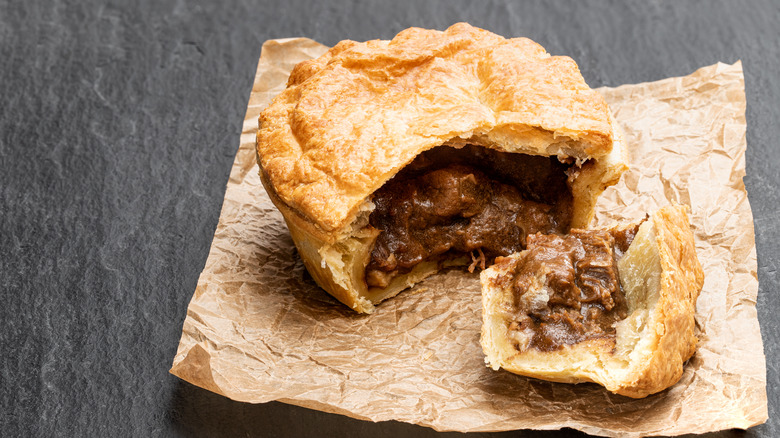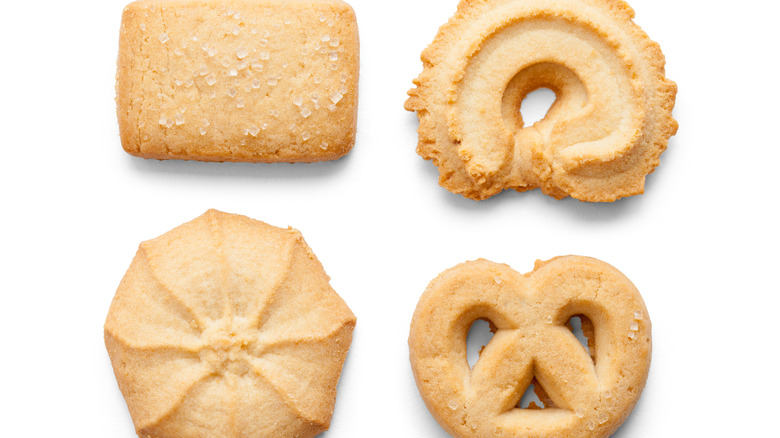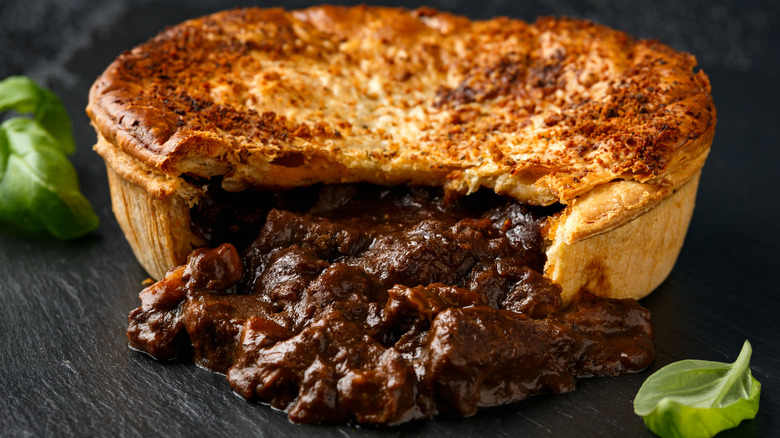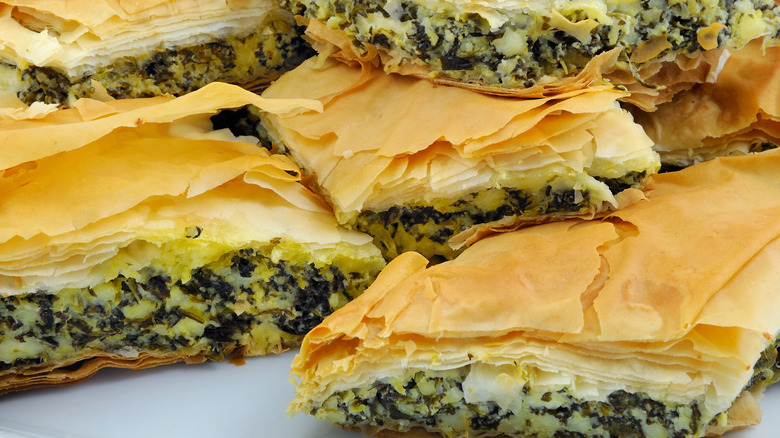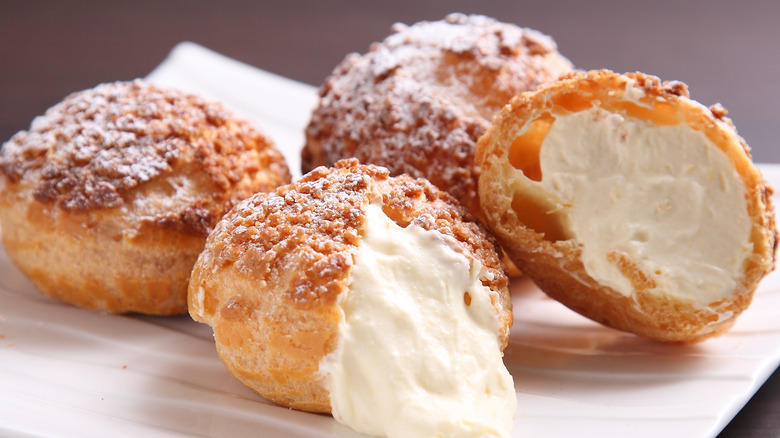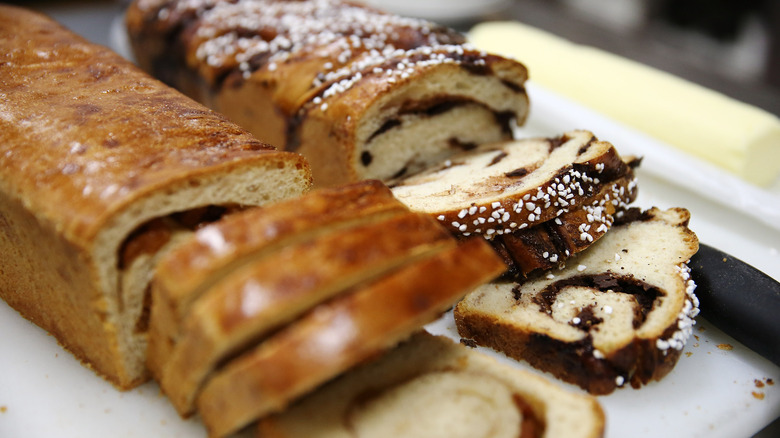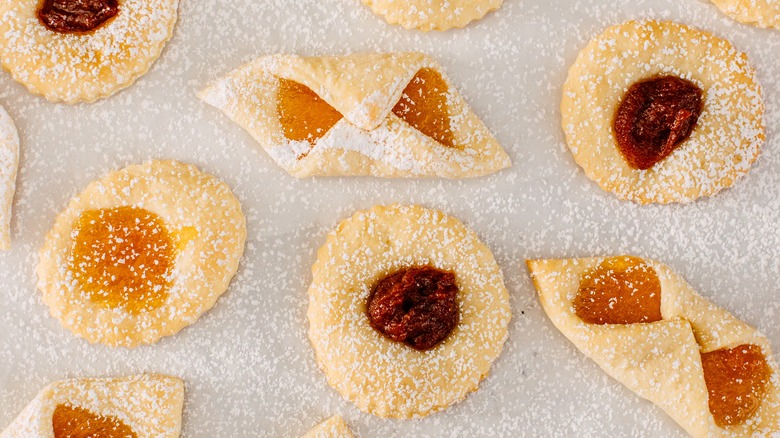A Beginner's Guide To Different Types Of Pastry Dough
There are few things better in life than a fresh, exquisitely made pastry. Pastry doughs come in all shapes and forms. And, of course, the many textures and types all make for a massive difference in the end result. Can you imagine a croissant without those beautiful buttery flakes or a cinnamon bun without the soft, lush dough? Probably not. Similarly, each kind of pastry dough has its own distinct flavors, which it will also lend to the final taste of a pastry. And with that also comes different techniques to create each.
It can be a little confusing trying to figure out what particular kind of dough a pastry needs or what the best type will be to suit your next baking project. That is why we are going to explain the different kinds of pastry dough: what they look, taste, and feel like. We'll also give you some pointers on how to make them so that the next time you need pastry dough, you will know exactly what to do with it.
Puff pastry dough
Puff pastry is the king of pastry dough — and as with many monarchs, it too requires some pampering and time. Puff pastry is made with a few core ingredients like all-purpose flour, salt, unsalted butter, and water. However, that is just the first component. The second part of this dough is where the magic happens. The dough is rolled out, and a large block of flattened butter is placed in the center and is then folded over itself.
These pastries can have around 729 individual layers of butter and dough in each pastry – or more, depending on the chef's techniques. As you can imagine, this results in a buttery, flaky, and decadent pastry dough. However, it does take a long time. Chilling the dough in between each layer helps to ensure the butter stays solid and that it gives the final pastry the correct rise. Rushing the process will result in a dense and non-flaky pastry.
This pastry dough is used to make classic desserts such as palmiers, danishes, and, at times, croissants. It should be noted, though, croissants call for a different type of dough that has salt, sugar, and yeast in the flour and water mixture. This ensures extra rise, but once again, it will require time to finish accordingly. Even though it's time-consuming, some people still use this puff pastry dough to make croissants. As puff pastry is time-consuming and a bit labor-intensive, many people opt for store-bought brands, which can be found in the frozen aisle at the grocery store.
Rough puff dough
A cousin to puff pastry, one that requires slightly less dedication, is the rough puff pastry. Rough puff pastry can also be called blitz puff. The idea here is that the butter is distributed in smaller pieces instead of using one huge block of butter. In some cases, this means using a cheese grater to shred the butter before folding. On YouTube, pastry chef Paul Hollywood recommends keeping the butter in the freezer to keep it cold. You do this so that when you fold over the dough, you do not need to chill it in between. This shredded butter easily rolls out but is cold enough to maintain its structure. This will give you a close approximation of a traditional puff pastry.
An even more accessible version sees butter being added to the dry ingredients before any liquid. The butter is broken down into small balls with the dry ingredients using hands, a pastry cutter, or even a food processor. This is where the blitz name comes in. The mixture is then lightly worked with water to form a dough. Since the butter is broken up and not in connected layers, it will not be as puffy as a traditional puff pastry but will provide some light and flaky goodness.
Flaky dough
The flaky crust is somewhere in between rough puff and shortcrust. It may even, at times, be considered one or the other. However, a flaky crust does not require the time-consuming folds of a rough puff pastry and does include liquid, such as water — which a shortcrust does not typically have. Still, there is some debate about where this crust falls, so we'll place it in its own category.
Flaky crust is made similarly to blitz-style rough puff. First, pieces of fat are cut into dry ingredients using fingers, a pastry cutter, or a food processor. If the latter is used, it is important not to overdo it, as the smaller the pieces, the less flaky the end crust will be. Once the pieces of fat have been incorporated, the cold liquid is added to bring the dough together.
The crust is then chilled to help keep the butter nice and cold and then rolled out. This will create pockets of butter that, when baked but will give flake, but not the same rise as puff or rough puff pastry, as it has not been folded and rolled to create lamination. This kind of dough is used for pie and quiche and is often simply called a flaky pie crust.
Shortcrust dough
Shortcrust is a name that describes a selection of pastry dough made of flour, water, and fat blended together, typically with some sugar mixed in. It gets its name from the large fat-to-flour ratio in the dough – fat can also be known as shortening, hence the short in shortcrust. The short dough is often used to make things like, unsurprisingly, shortbread cookies. For this, the dry ingredients are mixed with small pieces of butter. In this case, a food processor is fine since you are looking for total immersion, not large pieces. This will result in a crumbly texture rather than a flaky and puffy one. For this reason, you also do not need cold butter to start with. From there, sugar and eggs are often added in varying quantities to achieve the desired sweet and sandy result.
There are multiple kinds of pastry dough that fall under this category. Tarts often use pâte sucrée, a sweet french shortcrust dough made with added sugar. Some variations, such as pâte sablée and Milan shortcrust pastry, use almond flour in addition to or in place of wheat flour to add to the sandy crumbling texture.
Hot water crust dough
Hot water crust is one of the oldest types of crust around. We are going to be frank, though. You typically do not make a hot water crust for its flavor. The ingredients of a hot water crust are the same as a shortcrust, but with one crucial difference. Essentially, instead of cold water, hot water is added to the flour and fat. This has some benefits. For example, since you are adding hot water, you do not need to worry about your fat being in the proper-sized chunks, as it will melt anyway. It also creates a very sturdy crust that is excellent for crafting individual hand pies. That is why it gets used in shows like "The Great British Bake Off" when they are making towering pie dishes.
Unfortunately, there are some major drawbacks, mainly the taste. Because everything is melted into one homogeneous dough, there is no flake. The texture of the hot water crust tends to be tough and mealy. There is even speculation that traditional hot water crusts were really used more as a vessel, such as a paper bowl, only to be thrown away after. If you need the form, then this is a good one, but if you are looking for flavor, better to stick with a different crust.
Phyllo dough
Phyllo dough is the ultimate crispy pastry that is functionally all flake. One bite into any phyllo-wrapped pastry will leave taste buds happy and laps likely a little messy. Phyllo is made from flour, water, vinegar, and oil. Unlike puff pastry and short doughs, phyllo has relatively little fat in it. Instead of cutting in hunks of fat to give lift and flake, phyllo layers are all crafted by hand. The dough is made by mixing the ingredients together and kneading. Once together, it is divided into many small pieces and then rolled out into delicately thin layers. No matter how thin you think it needs to be, you should aim to go thinner. The phyllo should be nearly transparent and paper thin. The rolled phyllo dough sheets are then placed on top of each other to create lots of layers that, when baked, help to create a crispy heavenly dessert.
Phyllo was first created in Turkey but has spread to other parts of the world. It is predominantly used in dishes such as baklava and spanakopita. However, dough using a similar technique is also used to make strudel. Because of its delicate nature, using a high-gluten flour such as bread flour can be helpful to provide enough structure in the dough to hold up to all the stretching. Additionally, premade phyllo dough can be easily purchased in the frozen aisle of the grocery store.
Pâte à choux
Pâte à choux is a French pastry dough with some unique properties. The name choux literally means cabbages because the small piped pieces bake into puffy lumps that we guess look kind of like cabbages. Despite the less-than-appetizing name, choux is delicious. Pâte à choux is composed of many traditional dough ingredients, flour, water, butter, and eggs. However, it is the way it is prepared that gives pâte à choux a whole different presentation.
Pâte à choux is a twice-cooked dough. That is to say, it is cooked for the first time on the stovetop to create the dough and then baked once the pastry is ready to be made. First, the butter is melted on the stovetop and combined with the water and flour. This is cooked until it forms a stiff paste. Then the mixture is removed from the heat, and once it has cooled, eggs are beaten in to form the final dough, which will more closely resemble a thick cake batter or frosting. Unlike other doughs, due to the batter-like consistency, pâte à choux cannot be shaped by hand and is instead piped. After baking, it has a firm outside but is light and mostly hollow inside, perfect for stuffing with sweet fillings. Pâte à choux is used to make pastries such as eclairs, chouquettes, and cream puffs, among others.
Enriched dough
Enriched bread dough is a broad term that refers to bread that is made with added fat, sugar, and eggs. This often means with added butter. However, while the other pastry doughs on this list are predominantly cookie or crust doughs, when we are talking of enriched dough, we are specifically referring to the bready, enriched dough that is used as the foundation for many bread-like treats. This means the dough is fermented with yeast like other bread.
Brioche and challah are two examples of enriched dough. They are not suitable for the soft butter crumb or a squishy consistency. They also tend to be sweeter than their non-enriched counterparts.
While eaten on its own, enriched bread is delicious, as part of a pastry, it sings. Babka, for example, is made by rolling and twisting enriched dough with fillings such as chocolate to create a luscious sweet pastry. Desserts such as cinnamon buns and many donuts are also made with these sweet bread doughs. Can you imagine a cinnamon bun made with unenriched bread? It would be dry and would lose that rich texture. Instead, the enriched dough gives the cinnamon bun its decadent, satisfying taste and texture.
Cream cheese dough
Cream cheese dough is similar to shortcrust dough, but with one key difference: There is cream cheese. Like a shortcrust dough, it includes butter and flour. However, this dough combines butter and cream cheese before adding the flour. For this kind of pie crust, you do not necessarily even need sugar. The cream cheese adds a natural sweetness and tang to the dough, which does not need additional sugar to bring it to life. It also does not typically require additional liquid, as the cream cheese adds moisture.
Polish Kolache cookies often utilize this kind of dough, but that is not the dough's only use. Because of the incorporation of cream cheese, this dough holds together well and is easy to handle. For those who may have difficulty rolling out a flaky crust for a pie, this is a manageable and delicious alternative. Just be sure to chill the dough before rolling it out, as the cream cheese dough can get sticky when warm.
